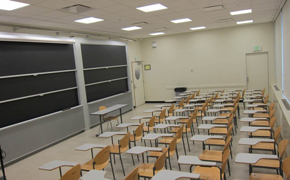Instructor Insights pages are part of the OCW Educator initiative, which seeks to enhance the value of OCW for educators.
Course Overview
This page focuses on the course 10.626 Electrochemical Energy Systems as it was taught by Professor Martin Bazant in Spring 2014.
Electrochemical Energy Systems consists of both graduate and undergraduate students. Students taking the graduate version complete additional assignments. Through lectures, readings, and problem sets, 10.626 introduces principles and mathematical models of electrochemical energy conversion and storage. Students study equivalent circuits, thermodynamics, reaction kinetics, transport phenomena, electrostatics, porous media, and phase transformations. In addition, this course includes applications to batteries, fuel cells, supercapacitors, and electrokinetics.
Course Outcomes
Course Goals for Students
The students learn the basic physics of electrochemical energy conversion, how to formulate mathematical models, make simple approximations, interpret experimental data, and design and optimize electrochemical systems. The concepts and models are intentionally very general and have many other applications such as desalination, biological membranes, and electrodeposition. Students interested in these and other topics also take the class to learn the basics of theoretical electrochemistry. The mathematical concepts, such as scaling analysis and asymptotic approximation, have broad applications outside of chemical engineering.
Possibilities for Further Study/Careers
One of the best outcomes of the class has been forming lasting relationships with students, who often ask me to serve on their PhD thesis committees or collaborate in research. In several cases, these interactions led to joint publications and new projects between my group and others at MIT. In one case, I ended up co-advising a mechanical engineering graduate student (W. Braff) whose PhD thesis work on membraneless flow batteries was directly motivated by lectures I gave on boundary layer analysis for microfluidic fuel cells.
Below, Professor Martin Bazant describes various aspects of how he taught 10.626 Electrochemical Energy Systems.
I created the class in 2009 as an attempt to synthesize theoretical electrochemistry across many disciplines with the goal of eventually writing a textbook on Electrochemical Physics, based on original notes and problems. I chose energy as the cross-cutting theme because there is tremendous interest in this field, also reflected in my own research on batteries, fuel cells and capacitors, but the course is organized around fundamental topics, such as thermodynamics, kinetics, electrostatics, and transport, that have many other applications. The subject fills a need at MIT and elsewhere for a quantitative course on electrochemical systems, especially relating to energy conversion.
I am self-taught in electrochemistry and originally trained as a theoretical physicist, and I try to bring this perspective to the students. Thinking like a physicist means that nothing is a “black box.” I never tell students “it can be shown” or give them formulae to memorize, but rather show them how to derive results themselves, at least approximately, from fundamental concepts and equations. In doing so, they come to understand the assumptions behind a given formula and see how to modify it for different situations.
The OCW notes were written by student “scribes” based on my lectures, as a homework assignment. I do this every year as a way to help the students cement their knowledge and to record what I teach for future classes, since there is no other textbook available (until I publish my own). The content varies each year to increase the overall coverage and depth of the full set of lecture notes, including many that are not on OCW.
Curriculum Information
Prerequisites
For graduate students: 10.50 Analysis of Transport Phenomena or permission of instructor
For undergraduate students: 10.302 Transport Processes
Requirements Satisfied
None
Offered
Every spring semester
Assessment
The students' grades were based on the following activities:
 40% Problem sets
40% Problem sets 30% Take-home midterm exam
30% Take-home midterm exam 30% Open-book final exam
30% Open-book final examStudent Information

Enrollment
Enrollment for credit typically ranges from 18-21 students. Each year the class attracts almost as many listeners, including postdocs, visitors and even other faculty members.
Breakdown by Year
The majority of the class consists of graduate students, plus several undergraduate students.
Breakdown by Major
The class was originally cross listed as a special topic in mathematics and chemical engineering, and it has since also attracted many students from mechanical and electrical, materials science, and physics.
Typical Student Background
Most students and listeners are interested in electrochemical systems based on their own research or career goals and manage to put the course content to practical use in diverse applications.
During an average week, students were expected to spend 12 hours on the course, roughly divided as follows:
Lecture
Three class sessions per week, each lasting one hour; 38 sessions total; mandatory attendance.
Out of Class
Activities such as:
- Readings
- Assignments
- Preparation for Exams
Semester Breakdown
| WEEK | M | T | W | Th | F |
|---|---|---|---|---|---|
| 1 |  |  |  |  |  |
| 2 |  |  |  |  |  |
| 3 |  |  |  |  |  |
| 4 |  |  |  |  |  |
| 5 |  |  |  |  |  |
| 6 |  |  |  |  |  |
| 7 |  |  |  |  |  |
| 8 |  |  |  |  |  |
| 9 |  |  |  |  |  |
| 10 |  |  |  |  |  |
| 11 |  |  |  |  |  |
| 12 |  |  |  |  |  |
| 13 |  |  |  |  |  |
| 14 |  |  |  |  |  |
| 15 |  |  |  |  |  |
| 16 |  |  |  |  |  |
 No classes throughout MIT
No classes throughout MIT Lecture session
Lecture session Problem set due date
Problem set due date No class session scheduled
No class session scheduled Optional office hours
Optional office hours Exam
Exam

 Room 1 of 1
Room 1 of 1 